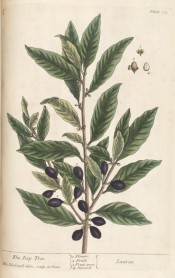Laurus nobilis L.
Frost hardy, evergreen conical tree or large shrub with glossy, ovate leaves, to 10cm long, and clusters of greenish flowers, to 5mm across, in spring, followed by black berries in female plants. To 12m. [RHSE, Hortus. Hilliers’].
Horticultural & Botanical History
An important culinary herb, cultivated in England since at least 1562. [PD]. ‘The Bay Tree. Laurus. The Bay Tree seldom grows to any great bigness here, the leaves are a dark green above & a pale underneath, ye flowers are yellowish and the berries black. It grows wild in Spain, Italy and France, flowering in May, the fruit being ripe in October. The leaves and berries are accounted heating, drying, and emollient good for wind in the stomach and bowels, helping ye colic, comforting ye head and nerves, preventing infections, provoking urine and the menses, & expelling the secundines. Outwardly they are used in warming and strengthening fomentations & ointments. Official preparations are, the Elect de Baccis Lauri; Emp. de Baccis Lauri; and the Oleum Laurinum.’ [Blackwell pl.175/1737].
History at Camden Park
Listed in all published catalogues [T.630/1843]. A very large clump, much suckered, probably originating from an early planting, still grows close to the house at Camden Park. A much-suckered tree also survives in the now abandoned Lower Garden, William Macarthur’s original garden.
Notes
Published Mar 03, 2010 - 11:38 AM | Last updated Jul 25, 2010 - 04:07 PM
| Family | Lauraceae |
|---|---|
| Category | |
| Region of origin | Mediterranean |
| Synonyms | |
| Common Name | Bay laurel, Bay tree, Sweet bay, Victor?s laurel, Poet?s laurel |
| Name in the Camden Park Record |
Laurus nobilis - Bay Tree |
| Confidence level | high |
